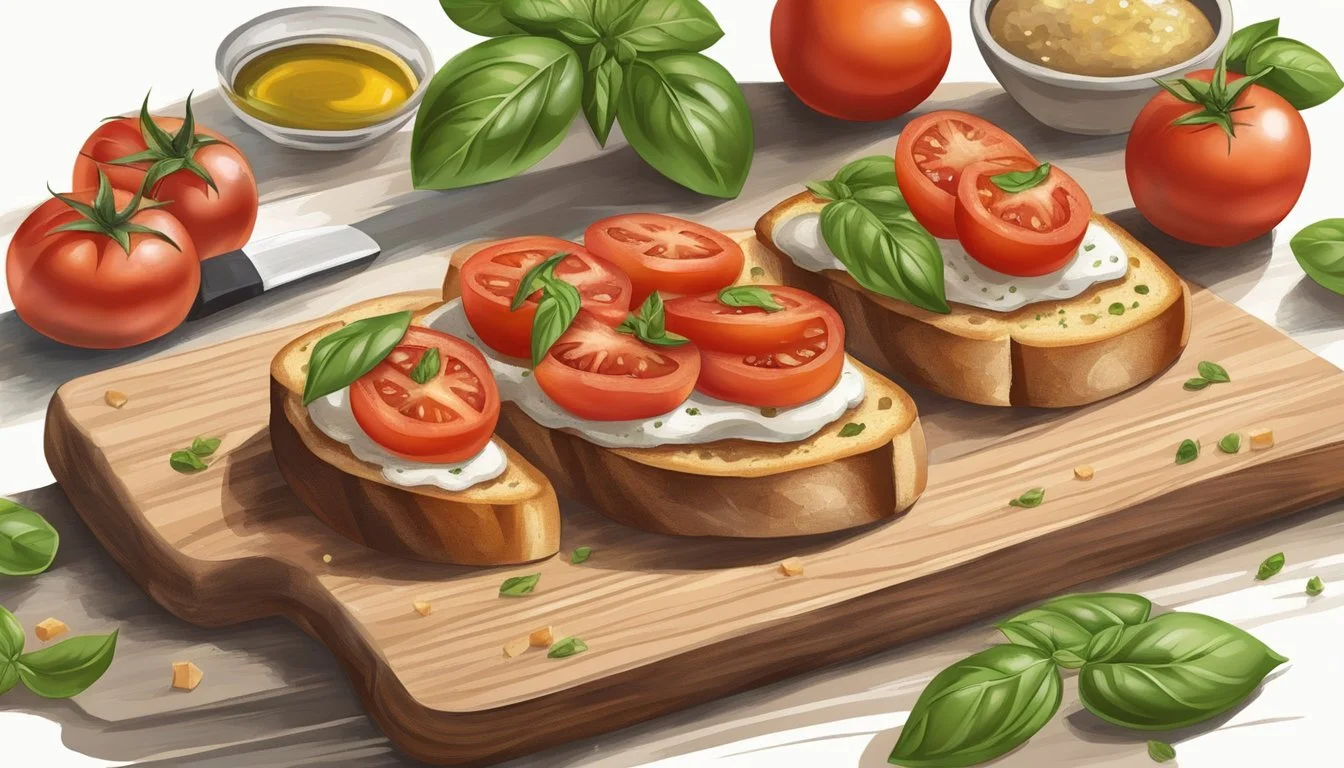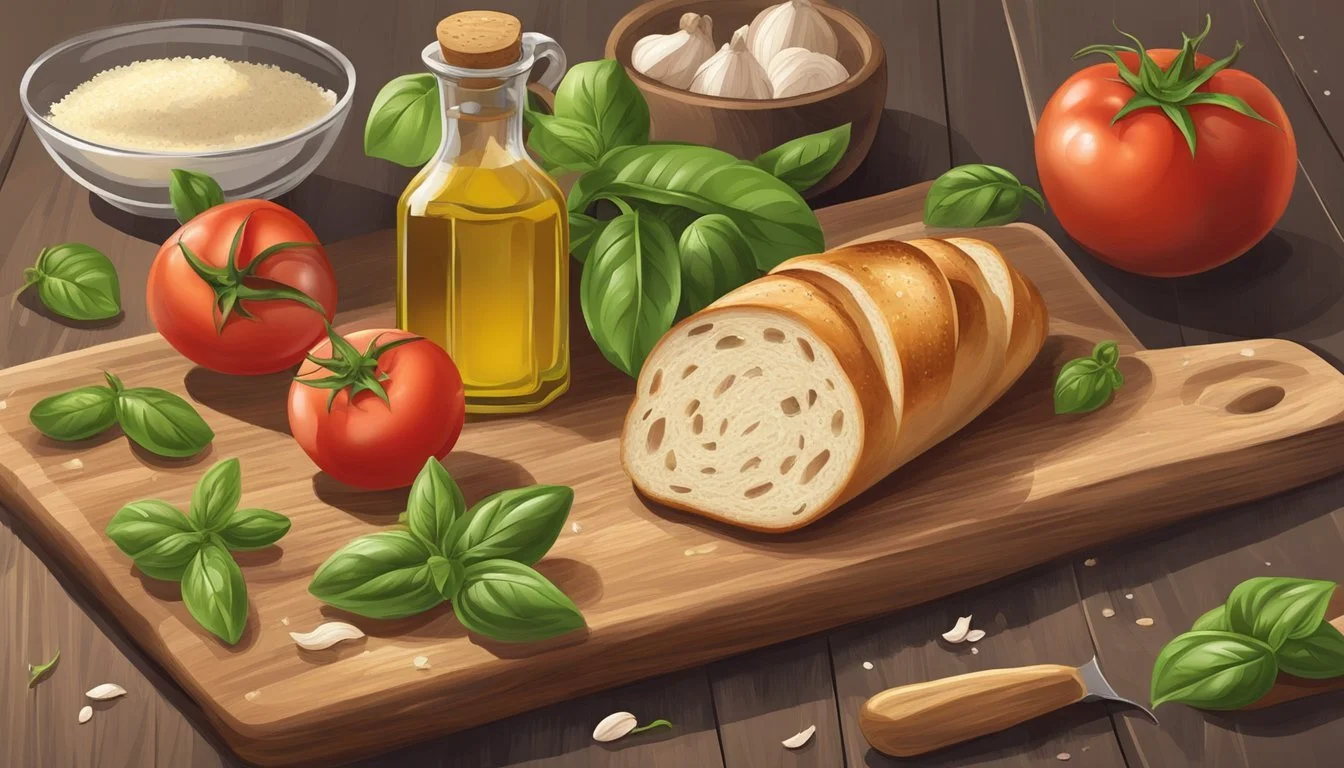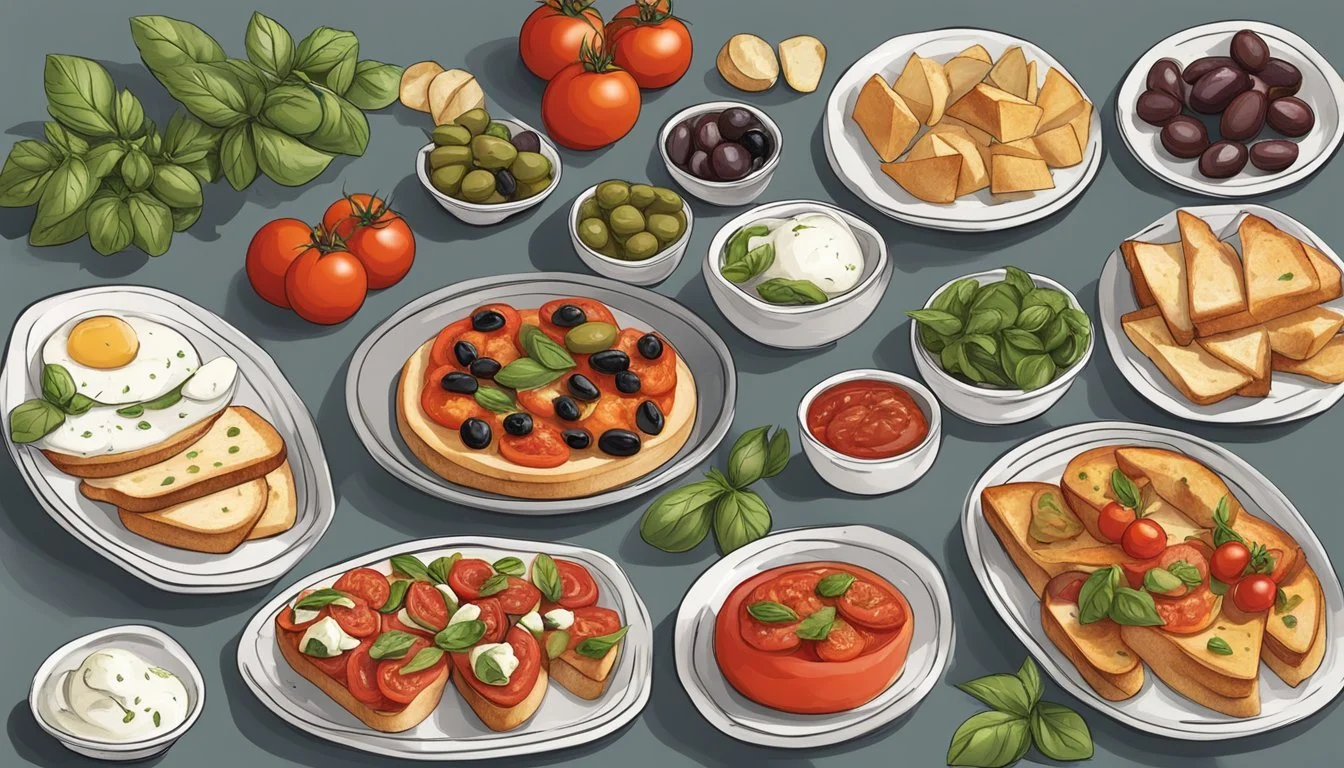Bruschetta Recipe
Healthy Delicious Snack Ideas for Every Occasion
Discover > Healthy Living Through Food > Bruschetta: Healthy Delicious Snack Ideas for Every Occasion
Bruschetta, a traditional Italian antipasto, has won over palates around the globe with its simple yet flavorful profile. This appetizer consists of grilled bread (how long does bread last?) rubbed with garlic and topped with a medley of diced tomatoes, fresh basil (how long does basil last?), onion, salt, and olive oil. Its roots date back to ancient Rome when olive growers would taste their freshly pressed oil on slices of bread. Today, bruschetta stands out as not just a delicious snack, but also a healthy one, embraced by those looking for a light and nutritious option.
The health benefits of bruschetta stem from its fresh ingredients. Tomatoes are rich in vitamins C and K, potassium, and the antioxidant lycopene, which has been linked to many health benefits, including reduced risk of heart disease and cancer. Olive oil, another central component, is known for its monounsaturated fats, which are considered heart-healthy. Furthermore, by opting for whole-grain bread as a base, one can add fiber to the diet, aiding in digestive health.
Bruschetta, a healthy snack, is versatile and can be customized according to personal taste preferences and dietary requirements. For those looking for a more robust flavor, additional toppings like chopped olives, (What wine goes well with olives?) capers, (What wine goes well with capers?) or anchovies (What wine goes well with anchovies?) can be included. Its simplicity allows for quick preparation, making bruschetta a go-to choice for a nutritious and perfect snack that does not compromise on taste.
The Basics of Bruschetta
Bruschetta is a classic Italian appetizer known for its simple yet vibrant ingredients, featuring crusty bread topped with a flavorful mixture of fresh tomatoes, garlic cloves, and black pepper. To elevate this classic, consider crafting your delicious bruschetta recipes.
Begin this appetizer recipe by slicing your bread of choice, like Italian bread, and placing the pieces on a baking sheet. Drizzle with a tablespoon of olive oil, ensuring each slice is coated for perfect crispness. The addition of cherry tomatoes adds a burst of freshness, making it a healthy bruschetta recipe option for any gathering or dinner party. With these key ingredients, you're on your way to creating not just bruschetta but a culinary experience that delights the taste buds.
History and Origin
Bruschetta originated in Italy, with its roots traced back to the ancient Romans who used olive oil-soaked bread as a canvas for various toppings. The name "bruschetta" comes from the Roman dialect 'bruscare', meaning 'to roast over coals'.
Defining Bruschetta
Bruschetta refers to both the grilled bread and the topping, which commonly consists of diced tomatoes, fresh basil, and garlic, bound together with olive oil. True Bruschetta highlights the quality of its ingredients rather than complicated preparation.
Essential Ingredients
The success of a bruschetta recipe relies on the freshness and quality of its key components. Below is a breakdown of its essential ingredients:
Bread: Typically, a rustic Italian loaf is sliced and toasted to achieve a crisp exterior and soft interior.
Tomatoes: Fresh, ripe tomatoes diced to provide a juicy, vibrant topping.
Basil: Fresh basil leaves enhance the mixture with an aromatic lift.
Olive Oil: High-quality extra virgin olive oil is drizzled for a rich, fruity flavor.
Garlic: Rubed onto the toasted bread or minced into the tomato mixture for its pungent essence.
This simple combination, when executed with care, creates a snack that is as nutritious as it is delicious.
Preparation Tips and Techniques
Creating the perfect bruschetta involves choosing quality ingredients and utilizing specific techniques to enhance the flavors. Correct preparation can make a significant difference in taste and texture.
Selecting the Perfect Tomatoes
The choice of tomatoes is critical in a bruschetta recipe. Roma tomatoes are often considered the best for their firmness and lower water content. To prepare them, one should:
Chop the tomatoes, ensuring that seeds and excess juice are removed to prevent the topping from becoming soggy.
Let the chopped tomatoes marinate to develop the flavor, ideally for at least 15 minutes.
Bread Choices and Toasting
The bread acts as a canvas for the bruschetta and should be chosen wisely. Baguette or French bread are popular choices for their texture and ability to hold toppings without becoming too soft.
Toast the bread slices until they are crisp and golden. This can be done in an oven preheated to around 200°C (392°F) for about 5-10 minutes or on a grill pan for a smoky flavor.
The exterior should be hot and toasted, while the interior remains slightly chewy.
Assembling the Bruschetta
The assembly of bruschetta is what brings all the components together:
Ensure the toasted bread has cooled just enough to handle. This helps to retain a crisp texture when the tomato mixture is added.
Toss the tomato mixture gently one more time, then top the toasted slices evenly to distribute the flavors.
The prep time and cooking time are minimal, making bruschetta an ideal quick and delicious snack.
Health Benefits and Nutritional Information
Bruschetta offers a combination of low-calorie satisfaction with a rich supply of various vitamins and minerals. It can be a heart-healthy option when prepared with whole ingredients and careful attention to portions.
Calorie and Macronutrient Profile
Bruschetta, traditionally a starter dish, is often recognized for its balanced macronutrient profile. A typical serving size contains:
Calories: 120-150
Carbohydrates: 15-20 g
Protein: 2-3 g
Fat: 3-5 g
Saturated Fat: 0.5-1 g
Polyunsaturated Fat: 0.5-1 g
Monounsaturated Fat: 2-3 g
Fiber: 1-2 g
Sugar: 2-3 g
These values can vary based on the ingredients and portion sizes.
Vitamins and Minerals Content
Bruschetta is rich in several essential vitamins and minerals, which contribute to its health benefits. Some key nutrients include:
Vitamin A: Essential for eye health and immune function.
Vitamin C: Important for skin health and immune support.
Calcium: For bone health.
Iron: Crucial for oxygen transport in the blood.
Potassium: Helps to maintain normal blood pressure.
Exact amounts of vitamins and minerals can vary with the specific vegetables and toppings used.
Dietary Considerations
When it comes to dietary considerations, bruschetta is accommodating to many dietary needs. It is:
Low in sodium: This can help in maintaining healthy blood pressure.
Rich in fiber: Beneficial for digestive health and can help to regulate appetite.
Heart-healthy: Due to the presence of monounsaturated fats from olive oil and polyunsaturated fats from vegetables.
Bruschetta can fit into a balanced diet, contributing to overall well-being without adding excessive calories or unhealthy fats. It is also customizable to be gluten-free or vegan, depending on the choice of bread and toppings.
Variations and Serving Suggestions
Bruschetta is a versatile snack that can be customized according to the season or personal preference. Its simplicity allows for a variety of ingredients and presentations, making it both a delightful appetizer and a complementary side.
Seasonal Twists
Spring/Summer: Utilize ripe heirloom tomatoes and fresh basil for a classic version. A drizzle of balsamic vinegar (how long does balsamic vinegar last?) enhances the flavor. For a novel addition, top with diced avocado or feta cheese.
Fall/Winter: Incorporate roasted vegetables and switch to heartier bread such as ciabatta. Experiment with seasonal toppings like butternut squash (how long does butternut squash last?), complemented by a sprinkle of sea salt (how long does sea salt last?).
Accompaniments and Pairings
Cheeses: A slice of mozzarella, a sprinkle of Parmesan, or a crumble of feta can add a rich texture and flavor.
Condiments: A spoonful of extra virgin olive oil, a pinch of salt and pepper, or a dash of balsamic vinegar can greatly enhance the overall taste.
Bread Base: Traditional bruschetta uses crispy crostini as a base, but baguette slices or thick-cut ciabatta can offer a delightful variation.
Storing and Freshness
To maintain freshness, store homemade bruschetta in an airtight container and keep it at room temperature if serving within a few hours, or refrigerate for longer storage.
Optimal Consumption:
Room Temp:
Best consumed within hours of preparation
Refrigerated:
Stays good for next-day service
For the best flavor, allow cold bruschetta to return to room temperature before serving.






